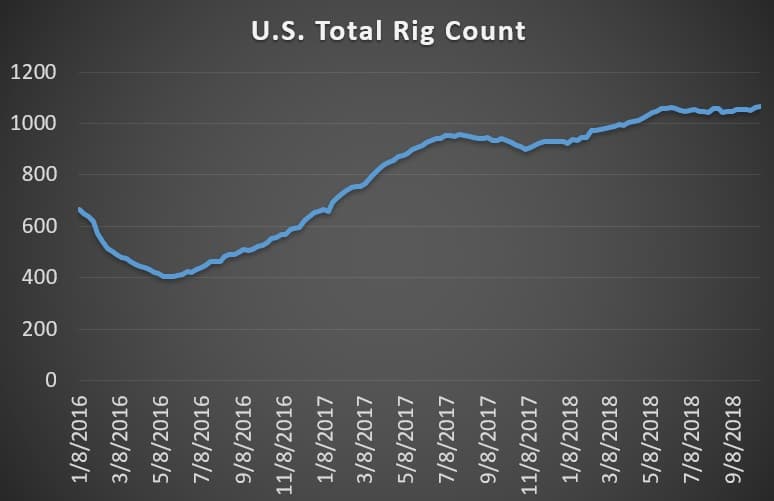
Oil prices fell drastically Tuesday morning despite Iran sanctions still looming over markets.




– The rupture of Enbridge’s (NYSE: ENB) natural gas pipeline in British Columbia on October 9 disrupted the fuels market on the entire northwest coast of North America.
– The interruption of gas flows into the U.S., in Washington State and Oregon, forced several oil refiners to cut back on refinery runs. That led to a shortage of gasoline and, thus, led to much higher prices.
– Retail gasoline prices in Seattle rose 9 cents per gallon for the week ending on October 15, the largest weekly increase since 2015.
Market Movers
• The Atlantic Coast pipeline received the greenlight from the state of Virginia to begin construction in the state. The $6.5 billion natural gas pipeline will help connect Marcellus shale gas to the U.S. southeast.
• Halliburton (NYSE: HAL) saw its share price fall more than 2 percent after reporting that its fourth quarter earnings would come in lower than analysts expect. The oilfield services company says fourth quarter fracking work will decline by a double-digit percentage.
• Saudi Arabia plans to sign deals worth more than $50 billion in the oil, gas, industries and infrastructure sectors at its “Davos in the Desert” summit in Riyadh. Beneficiaries include Trafigura, Total (NYSE:TOT), Hyundai (OTCPK:HYMLF), Norinco, Schlumberger (NYSE:SLB), Halliburton (NYSE:HAL) and Baker Hughes (NYSE:BHGE).
Brent dipped below $80 per barrel last week and crashed even further in early trading on Tuesday. Iran sanctions still loom, but oil prices are trending downwards at a rapid rate. “[T]he latest withdrawal of speculators and the negative price response since yesterday indicate that the market is not nearly as nervous as it was just a few weeks ago. One role in this is doubtless played by the fact that the oil market looks set to ease noticeably in 2019,” Commerzbank said in a note.
Halliburton says shale activity slowing down. Halliburton (NYSE: HAL) reported that its North American operations are slowing down, a sign that pipeline constraints are taking a toll on the shale industry. Earnings in the third quarter for the oilfield services company were 50 cents per share, up 19 percent from a year earlier, but down from 58 cents per share in the second quarter. The fourth quarter could be even worse. Pipeline bottlenecks are hurting activity, but “our customers’ budget exhaustion” also led to a weakening of demand for its services. However, Halliburton says earnings will rebound strongly next year.
OPEC+ to be formalized. Saudi oil minister Khalid al-Falih said that Saudi Arabia and Russia will forge forward to institutionalize the OPEC+ partnership, likely moving to create a Secretariat based in Vienna. The group’s coordination would not have an end date, nor would it target a specific production level. The comments, made in an interview with TASS, suggest the Saudi-Russian partnership could supplant OPEC in terms of importance, even if not in an official way. Al-Falih also tried to reassure the markets that Saudi Arabia would not use its oil production as a weapon in retaliation to any punishment from the U.S. related to the death of journalist Jamal Khashoggi.
Saudi Aramco: It would only take 3 months to get to 12 mb/d. Saudi Arabia has long maintained that it can produce 12 mb/d, implying spare capacity of around 1.3 mb/d at this point. Saudi Aramco’s CEO Amin Nasser said on Monday that it would only take 3 months to ramp up to that production rate.
Chevron ready to restart Wafra oil field if dispute resolved. Saudi Arabia and Kuwait are still at an impasse on the territorial dispute over the Neutral Zone oil fields, which total around 500,000 bpd of capacity. Chevron (NYSE: CVX) said it stands ready to restart production at the Wafra oil field in the Neutral Zone if the negotiations between Saudi Arabia and Kuwait reached a breakthrough. The fields have taken on added importance with the oil market tightening, as the market turns its attention to available spare capacity.
Trump admin eyes Eastern Gulf of Mexico. The Trump administration’s hopes of opening up new waters for offshore oil and gas drilling is increasingly focused on the Eastern Gulf of Mexico, an area that has long been off limits. The Trump administration has proposed to open nearly all of the U.S. coastline – including the Atlantic, Pacific and Arctic Oceans, plus all of the Gulf – but has run into political opposition in many places. In any event, the industry would be most interested in the Eastern Gulf of Mexico. “The eastern Gulf is really 99% of what all the operators care about,” Christopher Guith, a senior vice president for policy at the US Chamber of Commerce’s Global Energy Institute, told S&P Global Platts. “It’s really all that matters. It’s what they have the most data on, there’s some exploration at play and, more importantly, there’s some ancillary data from the existing exploration in the central Gulf.” For now, the Eastern Gulf remains off limits until at least 2022, and there is talk of extending the moratorium.
U.S. wants to delay IMO regulations. The International Maritime Organization has rules on marine fuels set to take effect at the start of 2020, and they are expected to significantly tighten the market for low-sulfur fuels. The Trump administration is hoping to phase the regulations in over time, the Wall Street Journal reports, although it is not clear how successful they will be. The regulations have been on the horizon for years, and the U.S. even has stricter requirements in place along its coastline. Given the fact that the rules take effect just as the 2020 presidential campaign will be hitting full swing, the Trump administration fears a political price from higher fuel costs.
France says EU financial vehicle could be used to evade U.S. The “special purpose vehicle” (SPV) that the European Union set up to help European companies to do business with Iran while evading U.S. sanctions could also be used to more broadly to avoid the extraterritorial reach of the United States. A spokeswoman for the French foreign minister suggested that the EU would explore other functions for the SPV. “It is therefore a long-term plan that will protect European companies in the future from the effect of illegal extraterritorial sanctions,” she said.
Record shale production fuels building boom for ports. Surging U.S. shale production is leading to a scramble for oil export capacity along Texas’ coast. Exports have routinely traded above 2 million barrels per day and could double to more than 4 mb/d within the next two years, according to S&P Global Platts Analytics. But, as of now, there isn’t enough export infrastructure to handle those volumes. Several companies are racing to build and upgrade ports capable of handling very large crude carriers. Only one U.S. port, in Louisiana, can do so currently. The problem is that not all of the ports on the drawing board necessarily make sense in the long run, putting a premium on the first movers.
Investors demand shale drillers consolidate. Private equity firm Kimmeridge Energy Management sent demands to Resolute Energy (NYSE: REN), threatening to install new board members if Resolute didn’t follow through on previous suggestions to find merger or asset sale opportunities, according to the Wall Street Journal. The activist campaign highlights angst from investors that some shale companies are still not profitable despite the significant increase in oil prices over the past year.
Permian ICE contract launches in Houston. A new oil pricing benchmark launched on Monday in Houston, highlighting the shifting nature of the shale industry. The Intercontinental Exchange Inc. (ICE), launched the Permian WTI futures contract, based on WTI delivered to Magellan Midstream Partners’ large terminal in East Houston along the Houston Ship Channel. The contract is intended to more accurately reflect market conditions along the Gulf Coast, where Permian oil is delivered, in comparison the Cushing-based WTI contract.
Hedge funds slash bullish bets. Hedge funds and other money managers cut their bullish bets on WTI for the sixth week in a row last week, as rising inventories and softening demand weighed on sentiment.




























